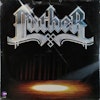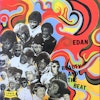From the time Luther Vandross was a young boy growing up on the Lower East Side of Manhattan in Alfred E. Smith housing projects, he knew he wanted to be involved in the world of music. “My friends and I would sit in our apartments listening to music and daydreaming about the singers we loved,” Vandross explained to me in 1996. “We wondered what it was like backstage at an Aretha Franklin concert or wonder if Diana Ross and Aretha, since they were both from Detroit, went to lunch together and then got their nails done. That would be the kind of stuff going through our minds.”
During his teen years, Luther formed his first group, A Shade of Jade, which featured his friend, guitarist Carlos Alomar. The entire ensemble performed in emerald green shirts and patent leather shoes. Other members included vocalists Anthony Hinton and Fonzi Thornton. “Luther was a visionary, even when we were young,” Thornton, who has sung backup for Chic and Roxy Music, said in a 2012 interview. “Luther was very advanced. He was always that same singer, that same interpreter.”
The ensemble ended when the boys were accepted into Listen My Brother, a group that worked out of the Apollo Theater. Overseen by Peter Long, who produced weekly variety shows and developed young music talent, Listen My Brother included other members Nat Adderley Jr., Robin Clark, Fonzi Thornton, and Patrick Adams. Vandross’s daddy, Luther Sr., who died when he was eight, had been a singer when he was young, so junior came by his vocal skills naturally and had no problem rehearsing so he could be perfect. Practicing in the basement of the famed theater, these kids would all eventually become soul shakers in the music industry.
However, first there were dues to be paid, songs to be sung, and professionals to be studied. A bigger fan of the divas than the male artists, Vandross often stood on the stage sidelines and watched as his favorite females (Patti Labelle, Gladys Knight, Nancy Wilson, and Dionne Warwick) rehearsed. Vandross took lessons at how they stood, how they handled the microphone, and how they worked the audience and the stage. Those Apollo days served as Vandross’s conservatory, the place that taught him the skills he needed (vocal arranging, production) to be a professional in the competitive world of New York City.
Peter Long had a storied career before coming to the Apollo. He had staged Billie Holiday’s Lady Sings the Blues concert in 1957 and produced the Miles Davis–Gil Evans Carnegie Hall concert in 1960. He also promoted the Monday-night jazz and Latin concerts at the Village Gate and the other Miles Davis–Gil Evans collaborations. In the mid-1960s, he went to work for the Apollo. Long put Listen My Brother on as the opening act for Isaac Hayes and Sly and the Family Stone, secured their first recording gigs, as well as a regular spot on a then-new show called Sesame Street.
A few years later, Luther became a fixture in local recording studios trying to get background work. His luck began to change when he traveled to Philadelphia with Robin Clark, who had married Carlos Alomar. The guitarist was at Sigma Sound with David Bowie, who was working on the “plastic soul” masterwork Young Americans. After the album was complete, Vandross joined Bowie’s touring band, and trekked across the world with him. The band included saxophonist David Sanborn, pianist Mike Garson, and vocalist Ava Cherry. That same crew also appeared with the glitter god on The Dick Cavett Show.
After the tour, Vandross sang backgrounds for Bette Midler and wailed advertising jingles for various products. However, for all his work, Luther wasn’t famous yet but was determined to get that way. Unfortunately, many labels passed on him until the fledging Cotillion, a subsidiary of Atlantic Records, signed Luther, which was also the name of Vandross’s group that included fellow vocalists Anthony Hinton, Christine Wiltshire, G. Diane Sumler, and Theresa V. Reed. Since the album obviously belongs to Luther the man, it does seem weird that Vandross would hide behind a group, especially since he wrote and produced every track, and was the auteur behind the project.
Cotillion Records executive Henry Allen, who would later contract Slave, Sister Sledge, and Cerrone to the company, signed Luther in 1975 and released their self-titled disc a year later. According to Craig Seymour’s brilliant biography Luther: The Life and Longing of Luther Vandross, “The just-promoted honcho took one listen to the demo recording of Luther’s thumping bass-driven number ‘It’s Good for the Soul’ and promptly made an executive decision.” The booming disco song closes out the album. Keyboardist Nat Adderley Jr., who would become one of Vandross main collaborators, sounds majestic on the track, the driving musical force that brings to mind Friday night at the Loft.
“It’s Good for the Soul” was as funky as any of the material coming out of Chic’s camp, as was the album’s blaxploitation-inspired opener “Funky Music (Is a Part of Me),” which sounded big, bad, and bold, the theme music Fred Williamson didn’t know he needed as he hustled with Rita Moreno in the opening credits of an imaginary movie. The song touched on several schools of disco including Gamble & Huff and Salsoul. Covered two years before on Young Americans by Bowie, who had changed the title and lyrics to “Fascination.” To me, Vandross’s version was the better record.
Since this was Vandross’s first big label deal, it was perhaps inevitable that there would be a couple mistakes and the biggest on Luther was the inclusion of “Everybody Rejoice.” Having written the song for the Broadway hit The Wiz, the joyful song was a celebratory song sung after the Wicked Witch was slain. Within the context of musical, the song worked perfectly, but on Luther I’m forced to question, why? The other slight misstep is the up-tempo “Emotion Eyes,” a dramatic dance jam with brilliant music and the dumbest lyrics ever written: “Emotion eyes see what they wanna see / They just won’t let it be / There’s always something going on / Emotion eyes, can’t seem to be without.”
The Luther album also served as the blueprint for establishing Vandross as the premier balladeer of his generation. On the album, the first slow jam was the beautiful “Second Time Around,” a maudlin song of lost love and renewed hope. Sounding as though he’d been recently played Warwick’s classic material, the song had a Hal David–Burt Bacharach vibe. The lush orchestration was highlighted by prolific sax man George Young, who smooth-jazzed it. The other slow-dance jam I dug was “I’ll Get Along Fine,” a brokenhearted duet that was simply beautiful.
For all of the musical sophistication, the packaging of the album, from the heavy metal letters on the front to the tacky photo on the rear, it looked as though Cotillion Records might’ve been unaware of how to market the group. Luther’s debut was cool, but the album failed to connect with an audience. “For the Luther album, Vandross put all the talent and ambition into that project,” writer Craig Seymour says. “That was his post-Bowie moment, and he was ready. The Luther project basically was guided by the same aesthetic that carried over to his future recordings and live shows.”
That same year, the group contributed to the Cotillion Records holiday album Funky Christmas, which included tracks by label mates Lou Donaldson, the Impressions, and Margie Joseph. The following year, Luther trimmed down to a trio and released the sophomore disc This Close to You. That record, which sported as equally appalling album design as the first, also bombed. The group was soon dropped.
Four years later, Luther Vandross signed with Epic Records and released his solo breakout album, Never Too Much. The album was nominated for two Grammys. He went on to become one of the defining voices of his generation until his premature death in 2005 at the age of fifty-four. At some point, Vandross bought back the two Luther albums from Cotillion and vowed they would never be reissued. While some of the songs have been re-recorded for other projects, the albums remain buried aural treasures just waiting to be unearthed.


